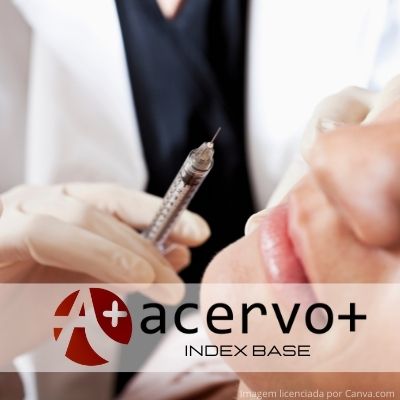O uso da toxina botulínica tipo A como alternativa terapêutica na disfunção temporomandibular: uma revisão de literatura
##plugins.themes.bootstrap3.article.main##
Resumo
Objetivo: Realizar uma revisão de literatura sobre os benefícios da aplicação da toxina botulínica no tratamento da disfunção temporomandibular. Metódos: Foi realizada uma revisão na literatura, por meio da base de dados Pubmed, com recorte temporal de 2017 a 2022, incluindo artigos em inglês e português, com a estratégia de busca: botulinum toxin OR botox AND temporomandibular disorder OR DTM. Resultados: A partir da análise dos títulos, resumos, e palavras-chaves, selecionou-se 24 artigos, sendo 12 do tipo bibliográficos, 9 experimentais, 1 caso clínico e 2 estudos retrospectivos. Resultando em um estudo efetivo sobre a toxina botulínica como alternativa de tratamento da disfunção temporomandibular, além de mostrar a eficácia da BTX-A não só em tratamentos estéticos como de forma terapêutica. Considerações finais: A partir desta revisão foi visto que a toxina botulínica pode ser uma boa opção de tratamento para a disfunção temporomandibular muscular, mostrando-se eficaz no tratamento da DTM.
##plugins.themes.bootstrap3.article.details##
Copyright © | Todos os direitos reservados.
A revista detém os direitos autorais exclusivos de publicação deste artigo nos termos da lei 9610/98.
Reprodução parcial
É livre o uso de partes do texto, figuras e questionário do artigo, sendo obrigatória a citação dos autores e revista.
Reprodução total
É expressamente proibida, devendo ser autorizada pela revista.
Referências
2. ÅGREN M, et al. The effect of botulinum toxin injections on bruxism: A systematic review. Journal of oral rehabilitation, 2020; 47(3): 395–402.
3. ASSIS ACV, et al. Preservação da fertilidade e quimioterapia: uma revisão integrative. Revista Eletrônica Acervo Saúde. 2022; 15(1): 1-9.
4. ASUTAY F, et al. The Evaluation of the Clinical Effects of Botulinum Toxin on Nocturnal Bruxism. Pain research & management, 2017.
5. ATARAN R, et al. The Role of Botulinum Toxin A in Treatment of Temporomandibular Joint Disorders: A Review. Journal of dentistry (Shiraz, Iran), 2017; 18(3): 157–164.
6. AWAN K, et al. Botulinum toxin in the management of myofascial pain associated with temporomandibular dysfunction. Journal of oral pathology & medicine: official publication of the International Association of Oral Pathologists and the American Academy of Oral Pathology, 2019; 48(3): 192–200.
7. BATIFOL D, et al. Effect of intra-articular Botulinum toxin injections on temporo-mandibular joint pain. Journal of stomatology, oral and maxillofacial surgery, 2018; 119(4): 319–324.
8. CHAURAND J, et al. Incobotulinum toxin type A for treatment of chronic myofascial pain. Journal of oral science, 2020; 63(1): 37–40.
9. CONNELLY S, et al. Clinical outcomes of Botox injections for chronic temporomandibular disorders: do we understand how Botox works on muscle, pain, and the brain?. International journal of oral and maxillofacial surgery, 2017; 46(3): 322–327.
10. GHAVIMI MA, et al. Effect of injection of botulinum toxin on decreasing the symptoms and signs of masticatory muscles in patients with temporomandibular dysfunction. Journal of dental research, dental clinics, dental prospects, 2019; 13(2): 128–132.
11. HOSGOR H, ALTINDIS S. Efficacy of botulinum toxin in the management of temporomandibular myofascial pain and sleep bruxism. Journal of the Korean Association of Oral and Maxillofacial Surgeons, 2020; 46(5): 335–340.
12. HUAMANI MA, et al. Use of botulinum toxin type a in temporomandibular disorder. RGO - Revista Gaúcha de Odontologia [online], 2017; 65 (2): 151-155.
13. KAYA D, ATAOGLU H. Botulinum toxin treatment of temporomandibular joint pain in patients with bruxism: A prospective and randomized clinical study. Nigerian journal of clinical practice, 2021; 24(3): 412–417.
14. KUCUKGUVEN A, et al. A Novel Injection Technique to the Lateral Pterygoid Muscle for Temporomandibular Disorders: A Cadaveric Study. Plastic and reconstructive surgery, 2021; 148(5): 785e–790e.
15. MACHADO D, et al. Botulinum Toxin Type A for Painful Temporomandibular Disorders: Systematic Review and Meta-Analysis. The journal of pain, 2020; 21(3-4): 281–293.
16. MALGORZATA P, et al. The Mechanism of the Beneficial Effect of Botulinum Toxin Type a Used in the Treatment of Temporomandibular Joints Dysfunction. Mini reviews in medicinal chemistry, 2017; 17(5): 445–450.
17. OKSANEN E, et al. Temporomandibular Disorder Patients Benefit From Intramuscular Botulinum Toxin Type a Injections. The Journal of craniofacial surgery, 2021; 00(00): 1–3.
18. OLENDER D, et al. Botulinum toxin application in the treatment of anterior disc displacement in TMJ – review of literature. Prosthodontics, 2018; 68(2): 223-231.
19. PATEL AA, et al. A systematic review of botulinum toxin in the management of patients with temporomandibular disorders and bruxism. British dental journal, 2019; 226(9), 667–672.
20. CALIS AS, et al. The use of botulinum toxin-a in the treatment of muscular temporomandibular joint disorders. Journal of stomatology, oral and maxillofacial surgery, 2019; 120(4): 322–325.
21. THAMBAR S, et al. Botulinum toxin in the management of temporomandibular disorders: a systematic review. The British journal of oral & maxillofacial surgery, 2020; 58(5): 508–519.
22. THOMAS N, ARONOVICH S. Does Adjunctive Botulinum Toxin A Reduce Pain Scores When Combined With Temporomandibular Joint Arthroscopy for the Treatment of Concomitant Temporomandibular Joint Arthralgia and Myofascial Pain?. Journal of oral and maxillofacial surgery: official journal of the American Association of Oral and Maxillofacial Surgeons, 2017; 75(12): 2521–2528.
23. VILLA S, et al. Improvement in quality of life after botulinum toxin injection for temporomandibular disorder. Journal of stomatology, oral and maxillofacial surgery, 2019; 120(1): 2–6.

